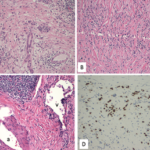Granulomatosis with polyangiitis (GPA) is a type of anti-neutrophil cytoplasmic antibody (ANCA) associated small vessel vasculitis that typically affects the kidneys, lungs and sinuses.1 Due to an overlap in signs and symptoms, GPA may initially be difficult to distinguish from IgG4-related disease, another condition that can affect multiple tissues and has variable presentations. Further complicating the diagnosis is that GPA is not always associated with an anti-proteinase 3 (PR3) antibody.2 Whether by extension through the sinuses or more directly, GPA can clinically present with inflammation of ocular structures. This presentation of GPA is rarer in children than in adults.3
The Case
An 11-year-old girl was sent to the emergency department by her primary care provider due to elevated inflammatory markers in the setting of intermittent hematuria and proteinuria. Laboratory testing at that time showed an elevated erythrocyte sedimentation rate (ESR) of 114 mm/hr (reference range [RR]: 1–10 mm/hr).
Laboratory tests were repeated in the emergency department, with similar findings, including an elevated ESR of 116 mm/hr. Her C-reactive protein was also elevated at 1.2 mg/L (RR: <0.9 mg/L). A urinalysis showed trace ketones, moderate blood and mild proteinuria. Overall, she was well-appearing with no other symptoms. She was discharged with a plan to follow up with a rheumatologist.
Despite the abnormal lab values, the patient appeared well and relatively asymptomatic at first consultation in our clinic, one month after her emergency department visit. She had no ocular symptoms, epistaxis or sinus pain. However, she had a history of frequent aphthous ulcers and a recent lymphadenopathy along the right side of her neck. A review of systems was otherwise unremarkable.
Due to the elevated inflammatory markers and the above history, additional laboratory tests were ordered, revealing the presence of antimyeloperoxidase antibody, perinuclear anti-neutrophil cytoplasmic antibody (P-ANCA) and anti-nuclear antibody (ANA), as well as anti-C1q antibody (see Table 1). The comprehensive metabolic panel, including creatinine, and complete blood count were unremarkable.
An ultrasound of the abdomen and neck was performed due to the patient’s intermittent lymphadenopathy; the results were unremarkable.
Computerized tomography (CT) of the lungs revealed no evidence of lung disease. However, a CT of the sinuses showed severe mucosal thickening within the ethmoid air cells, “with focal dehiscence of the right lamina papyracea.” A soft tissue mass was present within the medical extraconal space of the right orbit, affecting the right optic nerve, right globe and extraocular muscles. Findings were concerning for an inflammatory mass, such as an orbital pseudotumor. The radiologist considered infection unlikely.


